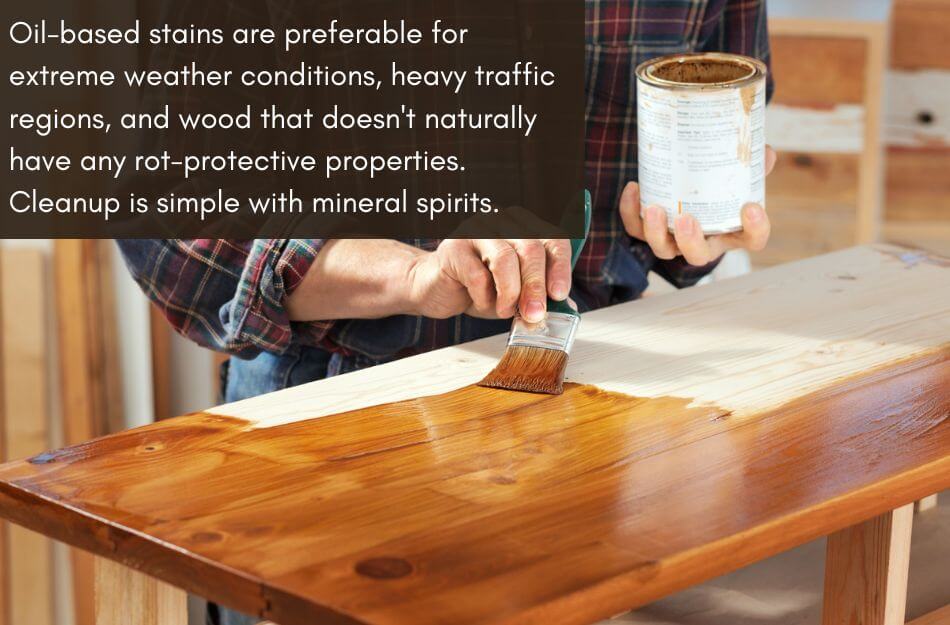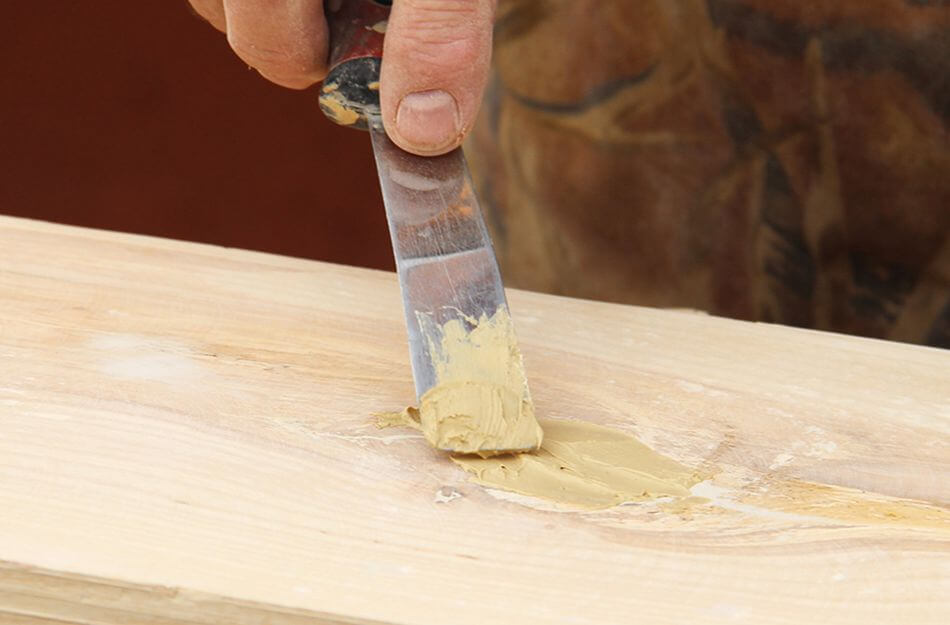Suppose you must stain a deck and are debating between using water-based or oil-based deck color. The wood you’re staining, environment, exposure, and durability determine your decision.
This decision is relatively easy because both dyes work well for deck staining. Both, though, have mutable characteristics. You need to decide which will complement your deck the best.
Oil-based stains are preferable for extreme weather conditions, heavy traffic regions, and wood that doesn’t naturally have any rot-protective properties.
Cleanup is simple with mineral spirits. Since cypress cedar and redwood are rot-resistant, water-based stains work best on these materials. The use of detergent and water for cleaning is also simple.

Table of Contents
Oil-Based Deck Stain
Oil-based stains have been used for years, and most now have more environmentally favorable formulas.
Instead of the oil-alkyd basis of the past, oil-based stains today use oil, such as paraffin, synthetic oil, or natural oils made from plants like Tung, linseed, and soybean.
However, some municipalities’ regulations, which guard against air pollution, forbid certain stains.
You can protect any wood surface against moisture damage using oil based stain because oil naturally wicks away moisture to avoid rot.
Oil-based stains work best for woods like spruce, pine, and fir that don’t naturally contain rot-resistant oils.
Due to their natural oils, redwood, walnut, teak, cypress, and cedar are rot-resistant and frequently more costly than other types of wood for decking.
Although most oil-based stains do so, it is best to verify the label, as certain brands don’t. Deep wood cell penetration by oil-based stains stops dampness from leading wood to split, fracture, check, or warp.
The protection is greater the more deeply the stain permeates.
Oil stains are advised for timber used for fences, rooftops, decks, pergolas, and other exterior structures and surface subject to harsh weather.
Oil resists freeze-thaw cycles preferably than other stains, making it a superior choice for regions with seasonal sub-zero temperatures.
Also Read: Deck Mud Vs Mortar: Understanding The Differences
How to Use?
Using a high-quality natural bristle brush, apply the stain to several planks from one end to the other for uniform coverage. A sponge, brush, or sprayer is another option.

Check the label for the drying time for oil-based stains because it varies depending on the quantity of resin. Cleanup is simple with mineral spirits.
However, it might be more challenging to dispose of the utilized mineral spirit in an environmentally responsible way. It is important to remember that some goods can also be cleaned with soap and water.
Before the treatment has to be reapplied, the discoloration should last for 5 to 7 years. It is simple to maintain by cleaning the surface, letting it dry, and applying the same substance again.
Use a deck cleaning product to clean up the grain and reapply color after several reapplications.
Benefits
- Oil-based stains give surfaces an even sheen and prevent lap lines.
- Oil-based stains are much simpler to apply since they absorb wood more easily and will adhere to the wood. Because the dry period is much longer, mixing your brush movements is easier to create an even additional finish.
- A poorly applied water-based stain will peel more easily than an oil-based stain because of how well it penetrates the wood.
- Oil-based stains will also last longer than water-based stains because of how well they infiltrate. You’ll see they don’t peel off when they fail; rather, they wane away.
- Easy to maintain
Drawbacks
- Oil-based stains won’t last as long as based on water stains
- It can contain more compounds like volatile organic compounds, which are dangerous to the environment.
- The resins that make up oil-based stains frequently contain materials that serve as a food source for mildew, mold, and algae, which can cause your deck to turn black.
- They take time to dry (up to 48 hours), which can be a real issue if you live in a damp climate.
- The lifespan of oil-based stains is disappointing
See Also: Deck Vs Patio: Choosing The Best Option
Water-Based Deck Stain
Water-based stains are relatively new to the exterior maintenance shelf than their oil-based peers, and their formulas are constantly being improved. The majority include:

- UV-blocking resins
- Plasticizing agents.
- .Antiseptics to fight mold and fungus.
- Liquid acrylic emulsion polymers.
Zinc additives help water-based stains withstand rot and microbial growth.
The performance of two-component water-based stains made of a blend of acrylic and polyurethane is superior to acrylic-only stains and less prone to weathering.
Water-based stains enable the timber to breathe, allowing moisture to permeate the surface before evaporating. Since the stain’s skin doesn’t trap wetness in the wood, it will not promote mold or mildew development.
Some water-based stains contain dangerous chemicals like glycol ether and toxic metals like zinc, despite most of them being VOC compliant and considered more ecologically friendly than oil-based stains.
Water-based stains don’t contain oils, so they are frequently suggested for use on redwood, cypress, cedar, and various other kinds of wood that naturally fight rot because they contain oils.
Additionally, you can use them to refinish timber that has already been stained with an oil-based product. Most stains have UV-protective pigments but can also hide the wood grain.
Ensure the clear pigment you intend to use has UV protection.
How to Use?
Use high-quality synthetic (nylon) bristle brushes, rollers, sponges, or sprayers to spread water-based stains.
Work from end to end across multiple boards simultaneously, spreading the stain equally to prevent overlapping lines.
Water-based goods frequently require two applications separated by four hours, and the drying time can reach 48 hours.
Even though they dry quicker than oil-based stains and can take 2 to 5 weeks to form a protective film or skin completely.
Although the effluent might not be environmentally friendly, cleaning up with soap and water is also fast and simple.
Don’t Miss: Deck Nail Vs Screw: What’s Best To Use?
Benefits

- Water-based stains do not provide a food source for mold, mildew, and algae, limiting their growth potential. As long as they are applied properly, water-based stains will last longer thanks to superior resistance to ultraviolet radiation and a better ability to keep their color. Zinc nanoparticle-containing stains will naturally be more resistant to mold development.
- With a water-based stain, cleanup is simple and requires no strong chemicals.
- These stains are non-flammable and have a mild odor.
- Because water-based stains tend to be more ventilated, you won’t get dampness trapped in the wood.
- This kind of stain sets rapidly, and you can walk on the deck one to two hours after application.
- When the finish starts to fade on some high-quality wood stains, you can clean the outside with detergent and water, restore a maintenance layer without sand, and strip it.
Drawbacks
- Apply water-based stains with more care and patience; don’t take corners. They will fail if you don’t give water-based marks the time they require. Smear the stain into the board completely.
- Water-based stains can peel if spread too thickly because they have a harder time penetrating the wood. Only use as much stain as the material can take.
What Makes Oil-Based Deck Stain Different From Water-Based Deck Stain
The major difference between the two stains is that one dissolves in water, and the other requires oil. It is known as the stain base or pigments solvent type.
Oil- and water-based deck stains behave differently due to the solvent’s properties.
Drying Time
Due to the ability of water to dry rapidly, water-based deck stains require a very short duration to dry out. Oil-based paints, on the other hand, require 24 hours to dry and are heavier than water.
Because 100% drying requires the dye’s solvent to vaporize completely, drying times vary.
Additionally, you must delay at least two to three days before painting the deck again with oil-based dyes. In contrast, water completely dissipates in 30 to 40 minutes, drying the platform made of water.
However, the environment has a greater impact on the paint’s cure period than the solvent. As a result, the cure periods for the two stains may vary.
Moisture-Resistance
Water-based deck stains do not resist moisture because water serves as their solvent. As a result, it rapidly absorbs water instead of oil-based stains.
Because of the top coat, oil-based wood paints usually have moisture resistance. The oil also defies water because it is insoluble in water.
Indoor Vs. Outdoor Usability
Both water and oil based dyes can be used inside and outside. Decide whether to paint the interior or external. Water-based stains dry rapidly and contain few paint additives or volatile organic compounds.
Therefore, water-based dyes are more typical for indoor stains than external ones.
In the open air, paint fumes can rapidly dissipate. Oil-based stains are, therefore, ideal for external use. Oil-based deck stains are more resilient and water-resistant, enabling the dye to blossom outside.
Related: Deck Mud Vs Concrete: Which is Best And Where To Use?
Cleaning and Maintenance
Maintaining your stain will ensure that it lasts longer. Both oil-based and water-based spots are easy to clean. Both, however, call for unique approaches.

While you can use a washcloth to remove water-based stains, you might need a wet fabric to remove tough stains. On the other hand, oil-based stains are simple to keep clean because they don’t gather dirt or grit.
Cost
Oils are a pricey source of basic materials. Oil-soluble items are, therefore, always expensive. Similarly to this, oil-based deck coatings are more expensive than water-soluble ones.
Oil-based colors are more expensive than water-based ones, so you need more. Using oil-soluble paints results in extra costs.
Oil-based stains appear to be significantly more scratch resistant than water-based stains. It is because oil-based pigments have a glossy sheen. The top coat protects the surface from dings and claw prints.
However, because the outermost layer is dry and lacks a natural sheen, water-based colors are quickly harmed by dents and scratches.
Quality And Endurance:
Oil-based deck dyes last longer and are more durable than water-based deck stains. Water-based pigments cure more quickly than oil-based deck stains, allowing the dyes more time to thicken.
Unlike water-based paints, oil-based stains last longer because they are stronger and withstand cracking, distortion, and scratches.
Oil-based dyes create a glossy appearance, whereas water-based stains create a dry, grainy surface. The paint has a glossy top coat; oil makes up a sizable part of the composition.
On the other hand, oil-based stains frequently result in a finish that is less vibrant and fresh than water-based hues. Therefore, your chosen choice will depend on how you feel about the coat finish.
Which is Better to Use?
The differences between water-based deck stains and oil-based wood coatings are numerous. Water-based colors are not waterproof, whereas oil-based deck stains are.
Therefore, both have different advantages. To determine which deck stain to use, look at their properties which have been discussed above.
Numerous variables determine whether oil-based stains are preferable to water-based stains and which is better.
Without even considering the stains themselves, factors like how the product is applied, the state of the wood, following the manufacturer’s directions, the weather, and other factors affect the comparison.
Although expensive, higher-quality products typically safeguard better and stay fresher.
You won’t notice a significant cost difference between applying a cheaper stain every two years and using a more expensive, higher-quality stain every five years for 10 to 15 years or more.
Of course, the expenses will be higher if you must replace the deck due to the cheap stain failing.
Oil-based deck stains typically perform better on most wood types and in extremely hot or frigid temperatures. Water-based stains perform well on wood with natural oil or wood previously stained with oil-based products.
Conclusion
Staining will shield your new deck, fence, or building from the particles, mold, and mildew. Weather, wood variety, and traffic should all be considered when deciding whether to use water- or oil-based.
Oil-based stains penetrate deeper and are more resistant to climate extremes.
In contrast, water-based stains typically have fewer VOC problems. So its depends on your choice which one you want to use by going through their properties, benefits and drawbacks.
Recent Posts
Although deck sealing may not be at the top of your summer to-do list, you shouldn’t put off a task.One such deck that channels the opposite of the lively and enjoyable vibe you want from an...
Any home would benefit from having a deck because it adds more area for socializing, relaxing, and outside activities.Garden decking that has been properly polished can be elegant and lovely. It...
